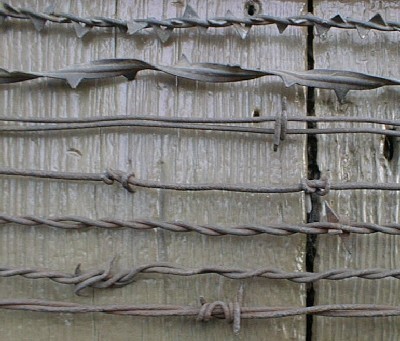Barbed Wire
Today, we copy nature to build a fence. The University of Houston's College of Engineering presents this series about the machines that make our civilization run, and the people whose ingenuity created them.
It's like finding forbidden fruit to find an invention that radically changes everyday life by imitating nature. Nature is too subtle. We seldom manage to copy her directly. Now historian George Basalla tells us about barbed wire.
We've tried to curb animal encroachments with thorny barriers since Medieval -- even classical -- times. That need for protection grew acute in the 19th-century American West. Farmers crossed the Mississippi into our vast central plains. Now they had to protect farms from free-running herds of sheep and cattle.
A small thorny tree, found in Texas, was called Osage Orange. It has straight twigs with long, sharp thorns. They're evenly spaced, and they grow radially at all angles. Texas merchants began selling Osage Orange seeds to farmers north of them. Farmers began growing thorny hedges. In 1860, Texas shipped 10,000 bushels of seed -- enough to grow 60,000 miles of fence.
Osage Orange worked, but it had disadvantages. It took three years to grow a fence. The fence could never be moved. It housed vermin. It shaded crops. Farmers needed something better.
Drawn wire was a medieval invention. It could be made into a simple fence, but one that wouldn't stand up to herds of cattle. We had, somehow, to combine the virtues of wire and thorn bushes.
Michael Kelly of De Kalb, Illinois, filed the first workable barbed-wire patent in 1868. He threaded little blade-shaped metal thorns onto one of two wires -- then twisted them together. He called it his "thorny fence." De Kalb was the gateway to the farmlands of the great plains. If this new product had come from anyplace, it would've come from De Kalb.
Kelly wasn't able to go into production until 1876. By then, several other De Kalb inventors had created their own imitations of Osage Orange. By 1880 De Kalb was turning out eighty million pounds of barbed wire a year.
The cattleman/sod-buster wars followed. And in WW-I the armies of Europe and America took barbed wire to their trenches. By then, of course, barbed wire had shaped the American Heartland.
We seldom manage to imitate nature that directly -- unless you include the fruits of the human mind in nature's rich array. We haven't yet made a successful airplane that can flap its wings like a bird.
Oh, we did manage to copy the cocklebur and create Velcro. Now and then we get away with it. And that's exactly what we did in the 1870s when we imitated the thorns of Osage Orange and created barbed wire -- when we copied nature and created the largest production of wheat and beef the world had ever known.
I'm John Lienhard, at the University of Houston, where we're interested in the way inventive minds work.
(Theme music)
Basalla, G., The Evolution of Technology. New York: Cambridge University Press, 1988, pp. 49-55.

Barbed wire samples assembled by Robert L. Myers